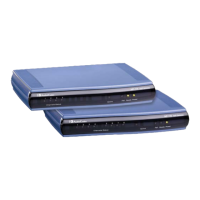Version 7.2 1043 Mediant 1000B Gateway & E-SBC
User's Manual 62. Configuration Parameters Reference
Parameter Description
received in the Refer-To header), and then
immediately releases the line (i.e., on-hook). The
PBX performs the transfer internally.
E1/T1 CAS: When a SIP REFER message is
received, the device performs a blind transfer, by
performing a CAS wink, waiting a user-defined time
(configured by the WaitForDialTime parameter),
dialing the Refer-To number, and then releasing the
call. The PBX performs the transfer internally.
[2] Semi Supervised = PBX semi-supervised transfer:
Analog (FXO): After receiving a SIP REFER
message from the IP side, the device sends a hook-
flash to the PBX, and then dials the digits (that are
received in the Refer-To header). If no busy or
reorder tones are detected (within the user-defined
interval set by the WaitForBusyTime parameter), the
device completes the call transfer by releasing the
line. If these tones are detected, the transfer is
cancelled, the device sends a SIP NOTIFY message
with a failure reason in the NOTIFY body (such as
486 if busy tone detected), and generates an
additional hook-flash toward the FXO line to restore
connection to the original call.
E1/T1 CAS: The device performs a CAS wink, waits
a user-defined time (configured by the
WaitForDialTime parameter), and then dials the
Refer-To number. If during the user-defined interval
set by the WaitForBusyTime parameter, no busy or
reorder tones are detected, the device completes the
call transfer by releasing the line. If during this
interval, the device detects these tones, the transfer
operation is cancelled, the device sends a SIP
NOTIFY message with a failure reason (e.g., 486 if a
busy tone is detected), and then generates an
additional wink toward the CAS line to restore
connection with the original call.
[3] Supervised = PBX Supervised transfer:
Analog (FXO): After receiving a SIP REFER
message from the IP side, the device sends a hook-
flash to the PBX, and then dials the digits (that are
received in the Refer-To header). The device waits
for connection of the transferred call and then
completes the call transfer by releasing the line. If
speech is not detected, the transfer is cancelled, the
device sends a SIP NOTIFY message with a failure
reason in the NOTIFY body (such as 486 if busy tone
detected) and generates an additional hook-flash
toward the FXO line to restore connection to the
original call.
E1/T1 CAS: The device performs a supervised
transfer to the PBX. The device performs a CAS
wink, waits a user-defined time (configured by the
WaitForDialTime parameter), and then dials the
Refer-To number. The device completes the call
transfer by releasing the line only after detection of

